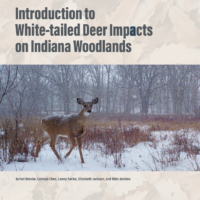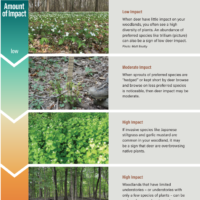 Purdue University - Extension - Forestry and Natural Resources
Purdue University - Extension - Forestry and Natural Resources
Got Nature? Blog
Deer are an important part of Indiana woodlands and represent a true conservation success story. Many Hoosiers spent time in the woods pursuing deer during hunting season or marveling at them during walks in their woodlands. But as recently as the 1930s deer were absent from Indiana woodlands. Restocking efforts led by the Indiana Department of Natural Resources helped reestablish deer populations across the state. However, deer populations have rebounded beyond what the land can support in many areas, leading to issues like crop damage, deer-vehicle collisions, and damage to woodlands.
Indiana woodlands. Restocking efforts led by the Indiana Department of Natural Resources helped reestablish deer populations across the state. However, deer populations have rebounded beyond what the land can support in many areas, leading to issues like crop damage, deer-vehicle collisions, and damage to woodlands.
Deer overabundance can pose a threat to the future health of many Indiana woodlands. Deer are considered a “keystone” species, which means their feeding habits (browsing) can shape our woodlands’ look and their plant and wildlife communities. This publication will outline some of the impacts deer can have on Indiana woodlands and what signs and symptoms to look for in your woods.
Learn more about the amount of impact in this new publication:
Low Impact: When deer have little impact on your woodlands, you often see a high diversity of plants. An abundance of preferred species like trillium (picture) can also be a sign of low deer impact.
Moderate Impact: When sprouts of preferred species are “hedged” or kept short by deer browse and browse on less preferred species is noticeable, then deer impact may be moderate.
High Impact: If invasive species like Japanese stiltgrass and garlic mustard are common in your woodland, it may be a sign that deer are overbrowsing native plants.
High Impact: If invasive species like Japanese stiltgrass and garlic mustard are common in your woodland, it may be a sign that deer are overbrowsing native plants.
Very High Impact: Browse lines indicate a severe deer problem and appear when deer browse all plants within their reach (<6 feet).
You can read this full publication for free at Introduction to White-tailed Deer Impacts on Indiana Woodlands.
View the Deer Impact Toolbox for more resources and videos.
Resources:
Purdue Extension Pond and Wildlife Management
Introduction to White-tailed Deer Impacts on Indiana Woodlands
Understanding White-tailed Deer and Their Impact on Indiana Woodlands, The Education Store
Monitoring White-tailed Deer and Their Impact on Indiana Woodlands, The Education Store
Managing White-tailed Deer Impacts on Indiana Woodlands, The Education Store
Ask an Expert: Wildlife Food Plots, video, Purdue Extension – FNR YouTube Channel
How to Build a Plastic Mesh Deer Exclusion Fence, The Education Store
Managing Your Woods for White-Tailed Deer, The Education Store
Bovine Tuberculosis in Wild White-tailed Deer, The Education Store
Handling Harvested Game: Episode 1, Field Dressing, video, Purdue Extension – FNR YouTube Channel
Deer Harvest Data Collection, Got Nature? Blog, Purdue Extension – FNR
How to Score Your White-tailed Deer, video, The Education Store, Purdue Extension Resource Center
White-Tailed Deer Post Harvest Collection, video, The Education Store
Age Determination in White-tailed Deer, video, The Education Store
Handling Harvested Deer Ask an Expert? video, Purdue Extension – FNR YouTube Channel
Subscribe to Purdue Extension-Forestry & Natural Resources YouTube Channel, Wildlife Playlist
Jarred Brooke, Wildlife Extension Specialist
Purdue Department of Forestry and Natural Resources

Recent Posts
- Woodland Management Moment: Maintaining Some Open Cover
Posted: November 13, 2024 in Forestry, Urban Forestry, Wildlife, Woodland Management Moment - Help Feed Hungry Hoosiers- MyDNR
Posted: in Community Development, Forestry, How To, Wildlife - Botryosphaeria Dieback and Canker, Purdue Landscape Report
Posted: in Forests and Street Trees, How To, Invasive Plant Species, Urban Forestry - Professor of Wood Processing and Industrial Engineering Rado Gazo Featured in ANR Newsletter
Posted: November 12, 2024 in Forestry, Wood Products/Manufacturing, Woodlands - Learn to Process Your Own Deer – Wild Bulletin
Posted: November 11, 2024 in Aquatic/Aquaculture Resources, Forestry, How To, Wildlife - Leaving Leaves Benefits Wildlife – Wild Bulletin
Posted: in Forestry, Forests and Street Trees, Gardening, Urban Forestry, Wildlife - Experience Indiana’s Sandhill Crane Fall Migration
Posted: November 8, 2024 in Forestry, Wildlife - Purdue Extension’s Showcase, Impacting Indiana
Posted: in Community Development, Forestry, Forests and Street Trees, Gardening, Land Use, Natural Resource Planning, Timber Marketing, Urban Forestry, Wildlife, Wood Products/Manufacturing, Woodlands - Deer Season is Here, MyDNR and Wild Bulletin
Posted: in Forestry, Wildlife, Woodlands - ID That Tree: Learn to Identify Hoptree/Wafer Ash
Posted: October 30, 2024 in Forestry, Forests and Street Trees, How To, Urban Forestry, Wildlife
Archives
Categories
- Alert
- Aquaculture/Fish
- Aquatic/Aquaculture Resources
- Ask the Expert
- Christmas Trees
- Community Development
- Disease
- Drought
- Forestry
- Forests and Street Trees
- Gardening
- Got Nature for Kids
- Great Lakes
- How To
- Invasive Animal Species
- Invasive Insects
- Invasive Plant Species
- Land Use
- Natural Resource Planning
- Nature of Teaching
- Plants
- Podcasts
- Ponds
- Publication
- Safety
- Spiders
- Timber Marketing
- Uncategorized
- Urban Forestry
- Webinar
- Wildlife
- Wood Products/Manufacturing
- Woodland Management Moment
- Woodlands